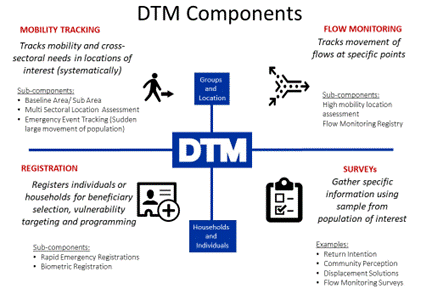The Displacement Tracking Matrix (DTM) is a system to track and monitor displacement and population mobility, provide critical information to decision-makers and responders during crises, and contribute to better understandings of population flows. DTM was first conceptualized in 2004 to monitor internal displacement in Iraq and has since been adapted for implementation in over 120 countries, including in contexts of conflict, natural disaster, complex emergencies and protracted crises.
DTM’s effectiveness in providing useful data in a diverse range of contexts relies on its ability to maintain a lightweight, flexible and modular structure, enabling quick adjustments and adaptation. To preserve operational flexibility, while promoting quality and coherence across DTM activities, various components, tools and methods have proven effective for quantifying displacement and mobility as well as for identifying needs and resources in DTM operations worldwide.
The four DTM Components are illustrated in the visual below:

2-pager Frequently Asked Questions on DTM for clusters in English, French and Spanish provide more information on:
- What is DTM?
- How does DTM work?
- How are data collected?
- What DTM information may be useful for Cluster response?
- How can Clusters/Sectors/WGs in countries use DTM information?
- How can DTM and Clusters further engage for the benefit of displaced persons?
- Are all DTM components rolled out in every country?
- Where can I find DTM reports and data?
See DTM Methodological Framework for more information
There are variations in DTM implementation from one country to another.
The specific methodology has an impact on the type of information DTM can provide. For example, partners should consider that DTM Multi-Sectoral Location Assessment (MLSA) collects information on locations, numbers, needs and resources at community level through interviews with non-sectoral expert Key Informants and Observation by enumerators who are not sectoral expert. Operations using MSLA or Village Assessment will therefore be able to collect specific types of information.
Refer to the methodological document of DTM in your country to know how, where and when data are collected or ask DTM team in your country to present the essential details of DTM implementation.
Available Tools
- FAQ on DTM for Clusters, (Frequently Asked Questions 2-pager available in English, French and Spanish, in: https://dtm.iom.int/dtm-partners-toolkit/what-dtm
- Methodological Framework used in DTM Operations for Quantifying Displacement and Mobility in DTM Operations, in: https://dtm.iom.int/about/methodological-framework
- What is DTM_What can you do with it. Power point presentation available in English, French and Spanish: https://dtm.iom.int/dtm-partners-toolkit/presentations-dtmen-fr-and-sp
- Presentations, guidance to using DTM for specific sectors and themes in: https://dtm.iom.int/dtm-partners-toolkit/dtm-specific-sectors
- Presentations on what DTM is in English, French and Spanish in: https://dtm.iom.int/dtm-partners-toolkit/presentations-dtmen-fr-and-sp
- Examples of information that can be collected by DTM MSLA for Partners to use in their decision-making are listed in Mapping_DTM MSLA Data commonly used by Partners: https://dtm.iom.int/dtm-partners-toolkit/information-needs-and-data-users
